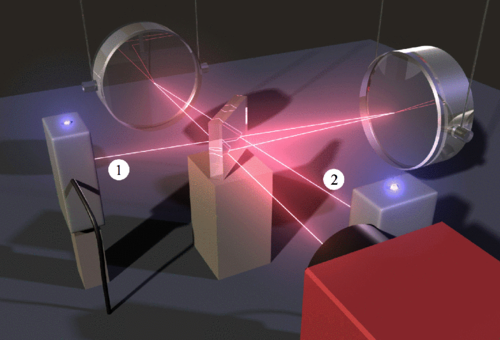August 5, 2015 report
Physicist unveils plan for entangling massive objects

(Phys.org)—Roman Schnabel, a physics professor at the Max Planck Institute for Gravitational Physics has published a paper in the journal Physical Review Letters outlining a plan for entangling two "massive" objects. He and his team are still working on a way to actually carry out the plan, but if successful, the group would succeed in entangling two 0.1 kg mass mirrors, which would represent a much larger example of entanglement than anything that has come before—up till now the largest objects to be entangled were of micron size.
Entanglement is of course the odd and perhaps a little eerie situation where two or more objects are connected in a way that cannot yet be explained—measuring one causes the other to be impacted instantaneously. The phenomenon was predicted back in the 1930's by Einstein, Podolsky, and Rosen. Over the years, scientists have developed ways to cause particles and then tiny objects to become entangled, but it still was not clear if a way could be found to cause objects large enough to be governed by classical physics to be entangled. In his paper, Schnabel draws up a means of achieving that goal, and notes that he believes it can be done.
Schnabel's plan is to place two of the mirrors in a Michelson-type interferometer in such a way as to have both sides of both mirrors hit by light that is sent in. The mirrors would also be placed in the interferometer in a way that would allow them to oscillate when struck by the light. This would allow for momentum to be transferred between the mirrors and the light. The mirror oscillations would then have an impact on the phase of the reflected light, causing the momentum and the light to become entangled. At that point, the entanglement could be "swapped" to the mirrors, causing them to be entangled, by measuring the light beams as they exit.
Testing that entanglement has occurred, he continues, could be done by switching off the light source to let the system proceed for a very short period of time before taking another measurement and then repeating it after one of the beam splitters has been turned off—over and over again.
Schnabel notes that there are several challenges that must be overcome before the experiment can be carried out, such as cooling the mirrors and preventing them from being impacted by the surrounding environment.
More information: Einstein-Podolsky-Rosen–entangled motion of two massive objects, Phys. Rev. A 92, 012126 – Published 28 July 2015. journals.aps.org/pra/abstract/ … 3/PhysRevA.92.012126
ABSTRACT
In 1935, Einstein, Podolsky, and Rosen (EPR) considered two particles in an entangled state of motion to illustrate why they questioned the completeness of quantum theory. In past decades, microscopic systems with entanglement in various degrees of freedom have successfully been generated, representing compelling evidence to support the completeness of quantum theory. Today, the generation of an EPR-entangled state of motion of two massive objects of up to the kilogram scale seems feasible with state-of-the-art technology. Recently, the generation and verification of EPR-entangled mirror motion in interferometric gravitational wave detectors was proposed, with the aim of testing quantum theory in the regime of macroscopic objects, and to make available nonclassical probe systems for future tests of modified quantum theories that include (nonrelativistic) gravity. The work presented here builds on these earlier results and proposes a specific Michelson interferometer that includes two high-quality laser mirrors of about 0.1 kg mass each. The mirrors are individually suspended as pendula and located close to each other, and cooled to about 4 K. The physical concepts for the generation of the EPR-entangled center-of-mass motion of these two mirrors are described. Apart from a test of quantum mechanics in the macroscopic world, the setup is envisioned to test predictions of yet-to-be-elaborated modified quantum theories that include gravitational effects.
Journal information: Physical Review Letters
© 2015 Phys.org




















